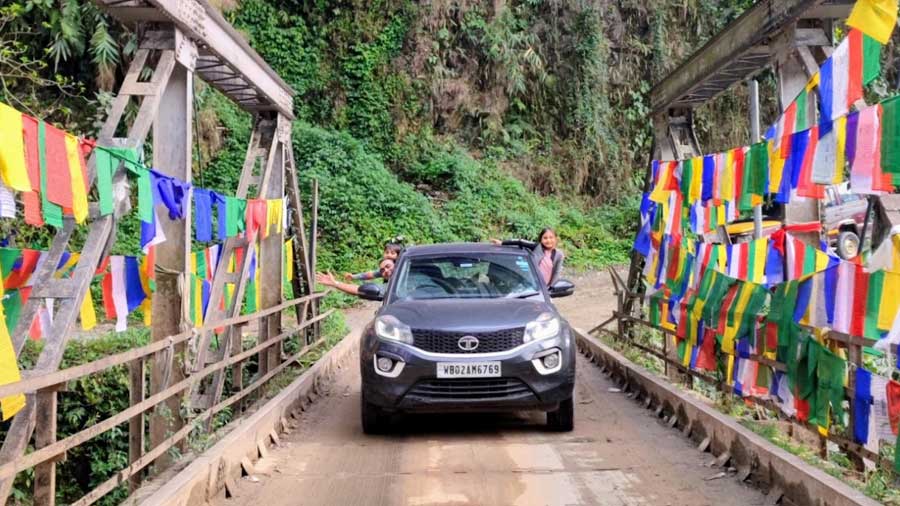They had warded off the French. Given the Americans a bloody nose. And is now taking an expansionist China head-on.
Does it ring a bell? Surely, yes.
It’s a hilly land with dense tropical forests — a country that once lent its name to a slogan that shook the streets of a city thousands of kilometres away in a different country.
Vietnam, situated on the eastern part of mainland Southeast Asia, is a land of stunning beauty but it was its politics of defiance — which had found resonance among communists in Kolkata — that got this writer hooked. So, when my childhood buddy, Chris, invited me over, I couldn’t say no and hopped on to the next flight out to explore the charms of his country, my first foreign trip since the pandemic shut the world down two years back.
The first impressions of a new visitor
The energy of a growing city is palpable, from the moment one lands at the Tan Son Nhat International Airport in Saigon, now known as Ho Chi Minh City. Vietnamese airports are chock-a-block with flyers, young and old, while the streets are packed with people sitting on tiny stools, enjoying Pho, the popular beef noodle soup served at roadside stalls and eateries across the country.
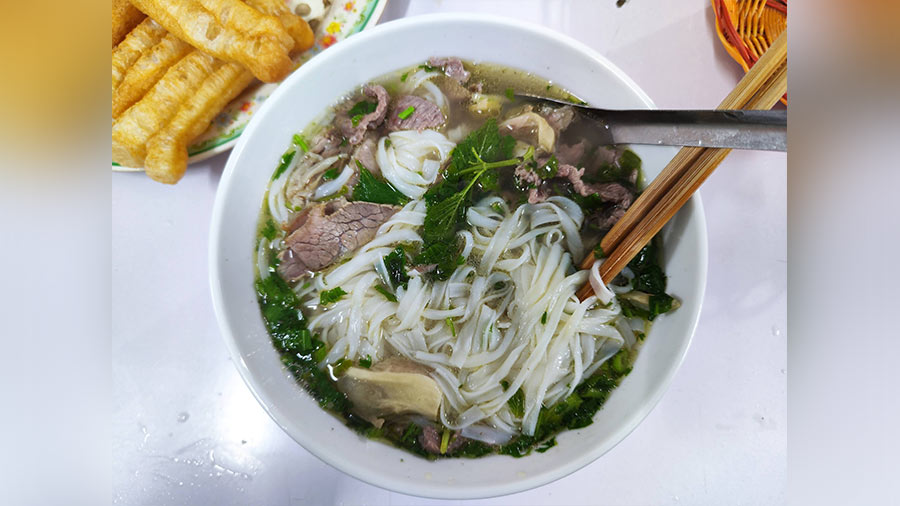
A bowl of Pho
The first impression for a new visitor is that of a bustling city. And then there is its name, Ho Chi Minh, that takes you back in time to the 1960s and the 1970s. A time when this city would reverberate with the slogan, “Tomar Naam, Amar Naam (your name, my name), Vietnam, Vietnam.” That sense of identification, which went beyond geographical boundaries, might not have happened without this man, Ho Chi Minh, one of the most influential communist leaders of the last century.
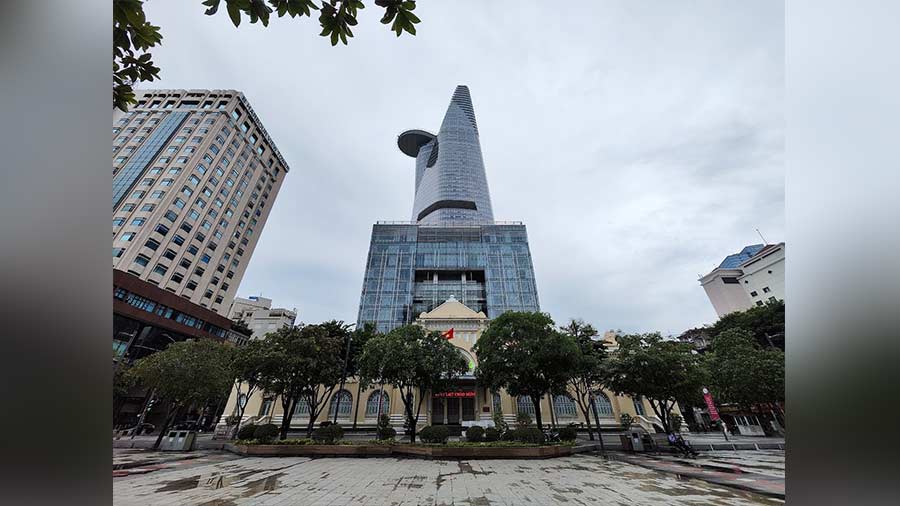
The old and the new co-exist in Ho Chi Minh City
I didn’t know who Ho Chi Minh was when I saw his bust for the first time while passing by the Kolkata Maidan. That was sometime in the 1990s. But I was intrigued. Who was this man with a wispy beard? There was nothing extraordinary about him. Nothing heroic. But the bust of the old man with a hint of a smile fascinated me. Kids and their wild imaginations have a way of focusing on things that catch their fancy.
Then I read up and learnt who he was — and also about the passionate solidarity between communists in Calcutta (as Kolkata was known then) and the communists in Vietnam. Today, local Vietnamese are, perhaps, completely unaware that such solidarity once existed, between folks in their country and people in another country.
‘Bhule jabo baba’r naam, Mone rakhbo Vietnam’
Ho Chi Minh’s struggle — he did not live to see Vietnam’s eventual reunification — against the far superior military resources of American troops had caught the imagination of the Left in West Bengal and become a rallying cry for the comrades who hit the streets in protest against what they saw as US imperialism. Of course, Soviet Russia and China had both lent their support in the war that pitted communist North Vietnam against the American-backed South Vietnam. But that’s a different matter. Coming back to the slogan, anyone growing up in Kolkata before the turn of the century would have been familiar with the words that punned on the phonetic similarity between the Bengali word “naam” (name) and the “nam” in Vietnam.
Another common saying heard during the Vietnam War was, “Bhule jabo baba’r naam, Mone rakhbo Vietnam”. A rough translation would be, “Can forget father’s name, but not Vietnam.” It was hard to miss the sense of empathy.
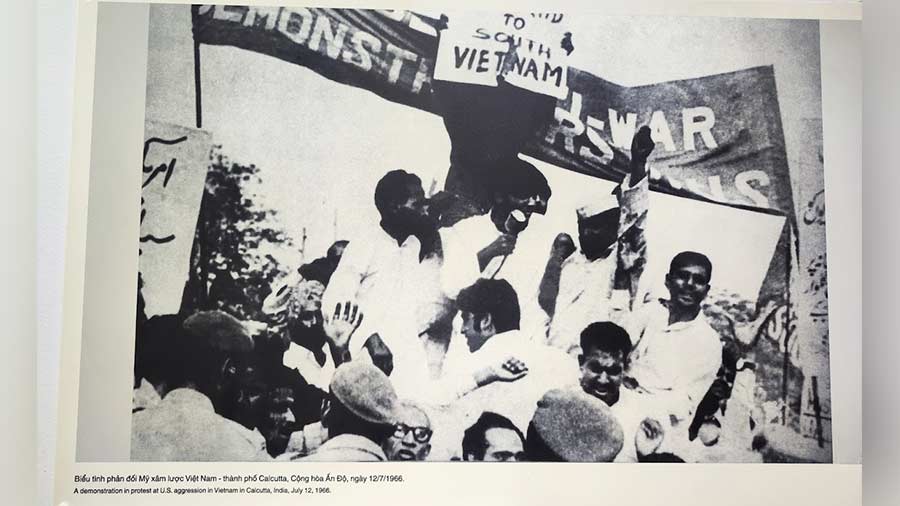
A demonstration in Calcutta in 1966 against US aggression in Vietnam
Earlier, in 1954, the French Indochina War had ended in Vietnamese victory over the French who were opposed to Vietnam’s independence, leading to a temporary division of the country.
In Kolkata, Ho Chi Minh has lent his name to a street that houses the US consulate, a cheeky jab at capitalist America from West Bengal’s then Leftist rulers. There’s also a plaque in the memory of his visit to the city and his stay at the Great Eastern Hotel, as the hotel was called then. Today, Vietnam has a small section dedicated to it at the National Library, the first country to have that distinction.
Best of frenemies
As for Vietnam’s relations with China, the two are as best of frenemies as any two countries can be. They share their ideological core of communism but also distrust each other as far as South China Sea territories are concerned. Most of the factories that shut shop in China have found a welcoming home in Vietnam. These days there’s less camaraderie and more competition between the two. On most parameters, Vietnam is growing faster than China and is becoming the first choice of companies looking for an alternative to the world’s factory, China.
Motorbike adventure
It was against this backdrop of history, nostalgia and unfolding geopolitical conflict that I flew into Ho Chi Minh City, the largest city in the Socialist Republic of Vietnam. I hadn’t made any plans for the trip when I boarded the flight. It was only after I had reached Saigon (as Ho Chi Minh City is still sometimes called) and met my “brother from another mother” that I learnt about the plans he had made.
“We’re going on a motorbike trip,” Chris announced when we met.
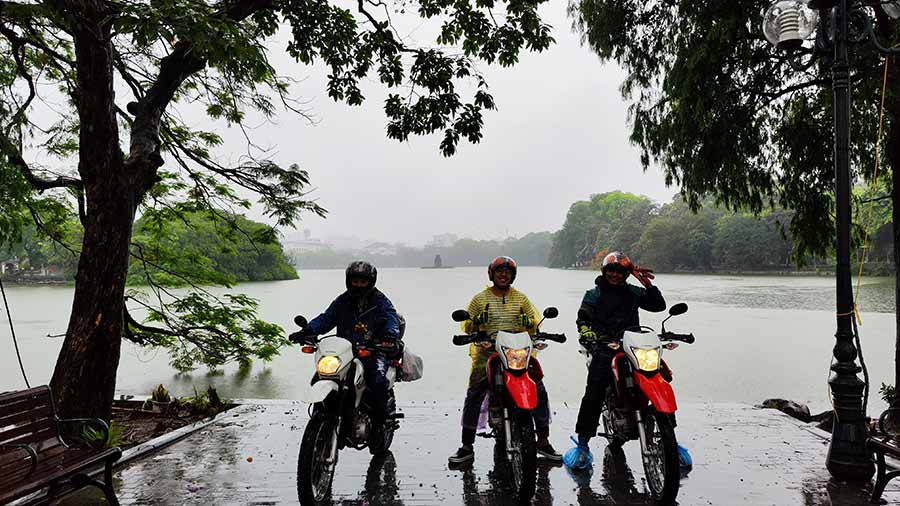
The adventure begins
I couldn’t have been more thrilled to hear that. A motorbike trip through the north of Vietnam for the next week was all that I needed to shake off the lingering effects of the pandemic-induced slowdown. We then flew into Hanoi, the capital, where our motorbike tour operator had everything figured out for us. After a good night’s rest in one of the many beautiful boutique hotels in Hanoi, Chris and I padded up for the next few days of our amazing adventure together.
For anyone planning a trip to Vietnam, hotel rates are quite reasonable in Hanoi, mainly because there are so many options available and the country is still opening up after the pandemic. One can book rooms in old boutique hotels from INR 1,500 to INR 3,000 a night. Vietnam is mostly warm and can be visited throughout the year.
Our bikes were light off-roaders — Honda XR150 — capable enough to take us through villages, across mountains, rivers and fields and past waterfalls that lay on our planned route. Vietnam follows driving on the right-hand side of the road, just like in the US, but once you ride a few kilometres, you get used to that.
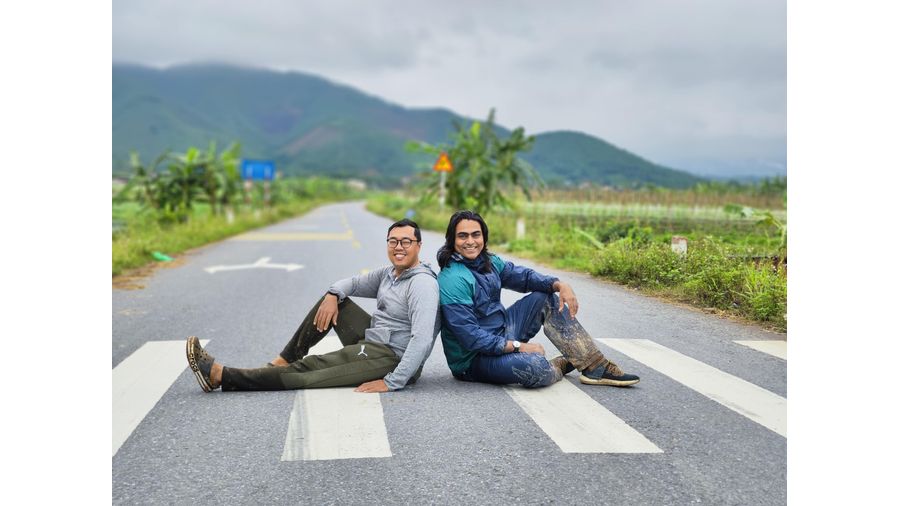
Chris and Iftekhar on the road, literally
The company we chose to go with was Indo China Motorbike Tours and you can see their various programmes on offer here.
Ours was a one-week adventure through rural Vietnam, through places whose names are difficult to pronounce but which are stunning in their natural, lush green beauty. The route covered Ban Lac, a model tourist village nestled among mountain ranges, where visitors can put up in homestays.
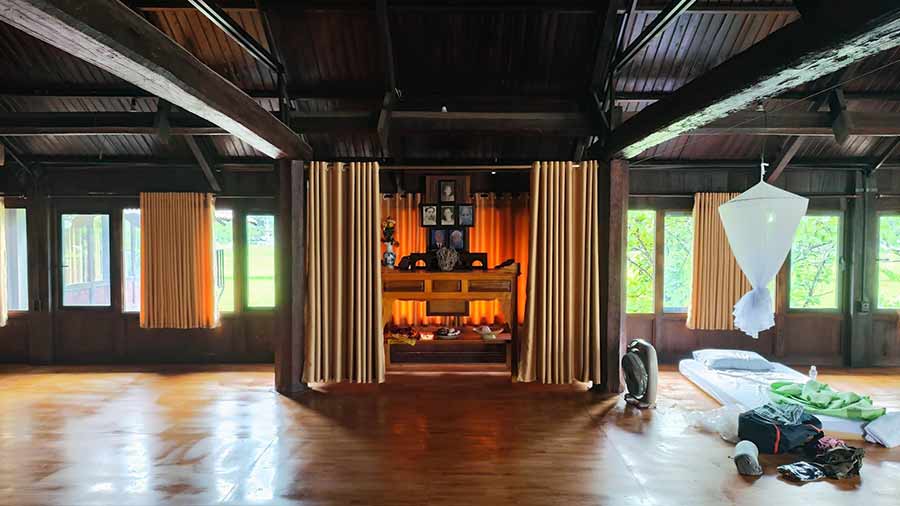
The homestay in Ban Lac
Chris and I could not help but brainstorm about the number of places in Bengal that could be converted into model tourist villages in a similar manner. This village is about 140km from Hanoi but our circuitous route and the many, many photo stops we couldn’t help but make ensured that we only reached by nightfall. We properly enjoyed the village only the next morning after a kind lady offered us lovely homemade Vietnamese food and board in the family’s large common hallroom. The morning was spent admiring the village, its wooden houses built on stilts and its open barbecue pits. Apart from us, there were Vietnamese tourists, too, who went around on bicycles and in golf carts, enjoying the rural experience.
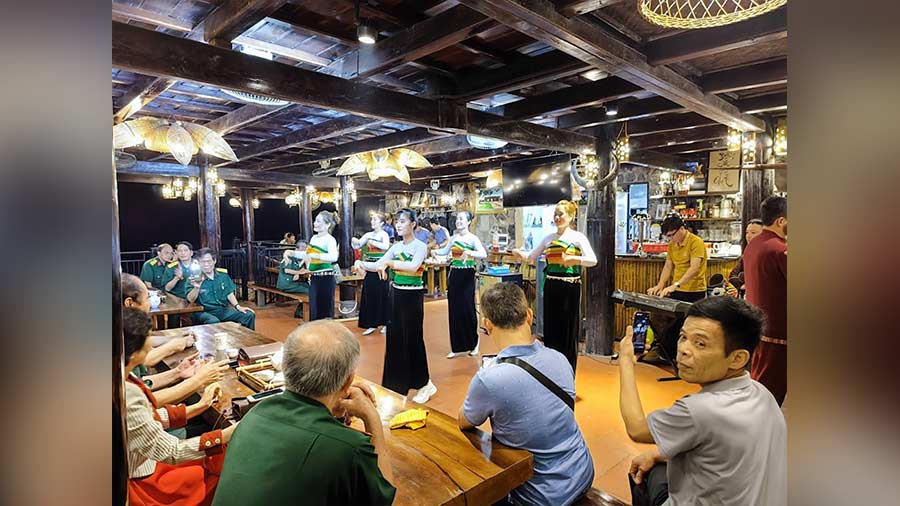
A dance performance at Phu Luong village
At Phu Luong, another village on our route in Thai Nguyen province, we saw a dance performance by local people at a police event. We stayed at an eco resort that gave us wooden barrels to bathe in. We later took a walk around the village, watching and learning from local lifestyles, and had dinner where we were served freshly caught snails.
Wherever you go in Vietnam you are amazed by how well the people live in harmony with nature. The use of traditional architectural styles and materials, food in tune with climatic conditions, and understanding of the ecosystems that exist; all seem to come naturally to the local people. For example, the house we stayed in when we halted at Ban Lac was built on stilts. Below the house is a pond, the source of freshly caught fish cooked and served to visitors. All houses grow plants, which make good use of the compost derived from household waste.

A well-balanced Vietnamese meal!
We also halted at Ninh Binh, a picture-perfect area also known as Ha Long Bay on Land because of its riverine landscape. Ninh Binh is popular with tourists for its delicious mountain goat meat, among other things.
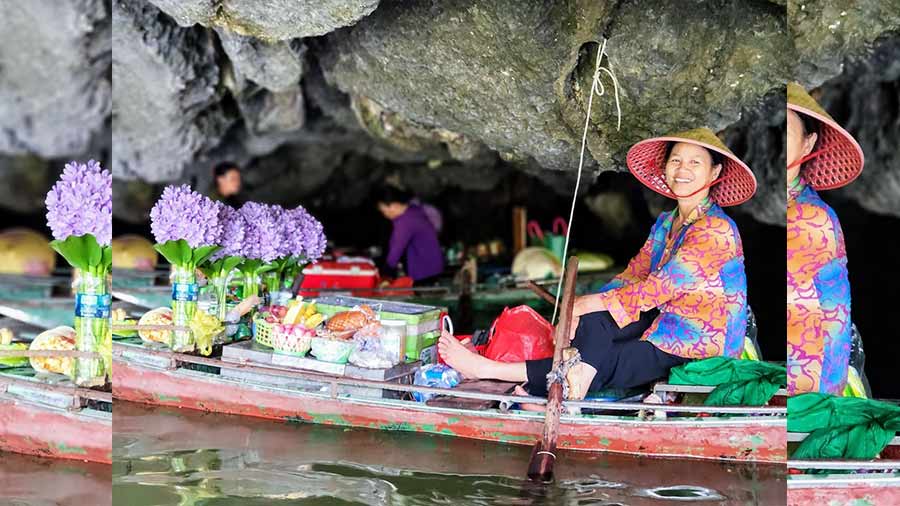
The floating shops of Ninh Binh
Absence of social hierarchy
But the most beautiful part of the trip, I felt, was the way people interacted with each other. The thing that strikes you while travelling through Vietnam is the complete absence of social hierarchy, a refreshing change from life in most other countries, including mine. Our motorbike guide, for instance, stayed with us and we even had meals together. There is little to differentiate between those who serve and those being served.

Giant irrigation wheels in Na Khuong village
Most of the local folks I met seemed to have been taken out of the depths of poverty and now enjoy a healthy middle-class life. Almost everyone rides a two-wheeler to work or play. The country also boasts a literacy rate of 95 per cent. It’s not surprising to see cars, perfumes, broadband internet, karaoke parlours and other such markers of urbanity deep in the country’s rural hinterland. People mostly eat out and public eateries serve fresh, healthy food fit for everyday consumption and mostly at reasonable rates.
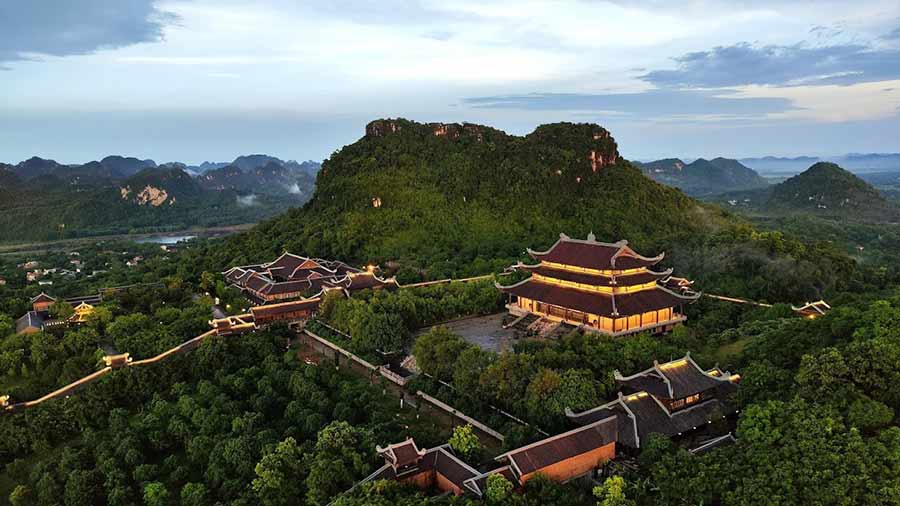
The Bai Din Pagoda
According to an Oxfam report, social indicators, such as education enrolment, healthcare insurance coverage and access to amenities (electricity, clean water and sanitary facilities) have improved significantly in Vietnam. “Notably, at the aggregate level, social inequality measured by the Gini index has increased only mildly from 0.34 in 1993 to 0.37 in 2004, despite a high annual economic growth rate of about 8 percent in the last decade,” the report said, adding that Vietnam had also made “commendable improvement in achieving economic and social rights as well as expanding civil and political participation”.
Those interested can read the full report here.
If such are the benefits of a communist state, surely there are lessons to learn for others?

